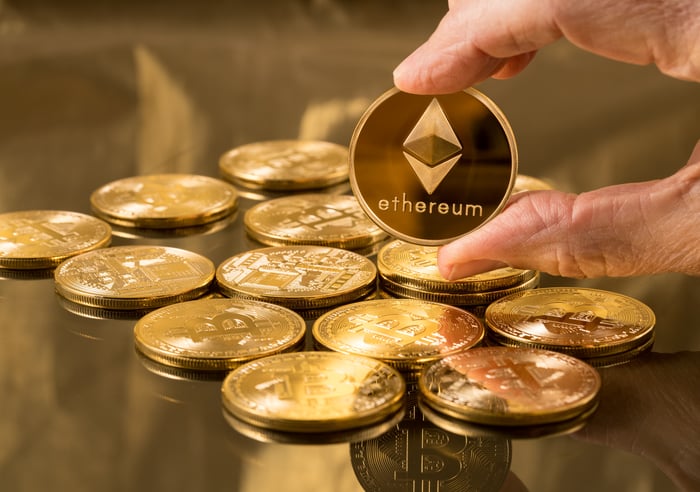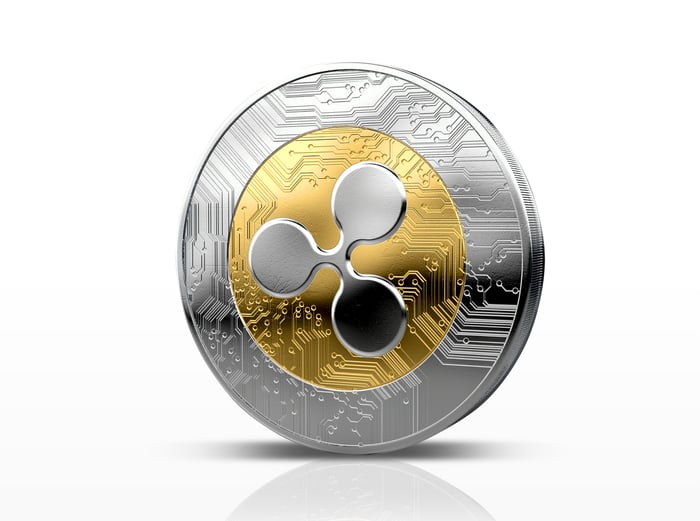It may be the holiday season, but cryptocurrencies have been playing the role of St. Nick for virtual currency investors since the beginning of the year.
When the calendar turned to 2017, the aggregate value of all cryptocurrencies combined was a mere $17.7 billion -- and bitcoin made up well over 80% of this value at one point. However, as of Dec. 14, the total cryptocurrency market cap had soared to $515 billion. For you math-phobic people, that's a return of more than 2,800%. For investors who've held throughout the entirety of this volatile year, they've possibly seen a lifetime's worth of gains.

Image source: Getty Images.
It's time we gave props to Ethereum and its 8,500% return
A lot of credit is often bestowed on bitcoin for fueling this digital currency rally, and with good reason. Bitcoin was the first tradable cryptocurrency, and it's the most widely accepted by merchants. Even now, with an aggregate market cap of $515 billion for all virtual currencies, bitcoin comprises 56% of that total.
But this rally is about more than just bitcoin. It's about the emergence of other coins and underlying blockchains that have the potential to effect positive change. Perhaps no cryptocurrency has stolen the spotlight from bitcoin in 2017 more than Ethereum. The Ether token has rallied by 8,500% this year, pushing Ethereum's market cap to $66 billion.
Why the newfound love for Ethereum among investors? It mostly has to do with Ethereum's blockchain. Blockchain is the infrastructure that digital currencies are built upon, and they're responsible for logging transaction data in a digital, distributed, and decentralized ledger. There are a host of advantages to blockchain technology, including the potential for cheaper transaction fees, since there's no middleman (i.e., bank) involved. Also, transaction settlement times could be particularly quicker utilizing blockchain since miners are working around the clock to proof encrypted transactions. This compares to traditional banking, especially cross-border transactions, where a payment or transfer of funds can be tied up for days while waiting to clear.
What's really lit a fire under Ethereum this year is the formation of the Enterprise Ethereum Alliance. Currently boasting 200 members, this Alliance is testing a version of Ethereum's blockchain across an array of industries in various pilot and small-scale projects. Few folks would deny the potential that blockchain can bring to the table, and it appears that Ethereum has done an exceptional job in attracting enterprise clients.

Image source: Getty Images.
Surprise! These three digital currencies were even better than Ethereum in 2017
But when all is said and done, Ethereum's 8,500% gain, while more than four times that of bitcoin in 2017, falls short of the return that a few of its peers delivered. Here are three cryptocurrencies that actually left Ethereum eating their dust this year.
Ripple: up 10,900%
With the fourth-largest market cap of all cryptocurrencies, Ripple's XRP has gained a whopping 10,900% since the year began. The interest in the XRP appears to tie in with its proprietary blockchain that's focused on financial service companies. In particular, Ripple's blockchain could allow for cross-border payments and transactions that occur instantly, rather than waiting those aforementioned days as under the current system.
The news that really sent Ripple soaring in 2017 was the announcement that American Express (AXP -0.54%) and Banco Santander (SAN 0.52%) would be using Ripple's blockchain in certain cross-border transactions. The partnership will process non-card payments to U.K.-based Banco Santander accounts through Ripple's blockchain. More importantly, these transactions are expected to be instantaneous.
There's also the belief that Ripple's coin, the XRP, will play a key role in expediting remittances in the future. For instance, the ability to transfer from one currency to another instantly becomes possible with the XRP as the intermediary currency. Clearly, there's a lot of excitement surrounding Ripple.

Image source: Getty Images.
NEM: up 14,000%
Though NEM, and its virtual currency XEM, are lesser known, the ninth-largest cryptocurrency by market cap has done particularly well in 2017 (up 14,000%)! Just shy of an all-time high, NEM's market cap is nearing $5 billion.
Similar to Ripple, the buzz with NEM is all about its blockchain and the ability to transfer money securely and efficiently. However, NEM appears to be broadening its reach beyond just enterprise clients. It's all about peer-to-peer payments and transfers, regardless of whether it's person-to-person or business-to-business. With the NEM Foundation based in Singapore, its partnerships have primarily been concentrated in Southeastern Asia.
Perhaps most notable was the September announcement of a partnership between NEM and the Malaysia Digital Economy Corporation (MDEC), a government-owned institution charged with managing digital infrastructure and security, and advising on technology-related laws in Malaysia. The MDEC also promotes relationships between high-tech businesses, meaning this partnership could lead to an abundance of Malaysian (and perhaps Southeast Asian) companies testing out NEM's blockchain and incorporating its token, the XEM.

Image source: Getty Images.
Einsteinium: up 169,800%
But one of the top single-year performances you'll ever witness as an investor is the return delivered by the 43rd-largest cryptocurrency by market cap, Einsteinium. This little-known virtual currency began the year at $0.000875 per EMC2 coin (apropos name, am I right?), and recently vaulted to north of $2 per coin. Currently, it's sporting a nearly 170,000% return. If you had the gall to invest $1,000 in this at the beginning of the year, you'd have around $1.7 million.
So, what on Earth would cause a virtual currency to explode 170,000% higher? Probably the biggest single event was the announcement in October of a hard fork that was designed to reduce the number of EMC2 coins by 50 million. This hard fork was completed on Dec. 10. Think about this like an investor: when a company issues stock to raise capital, it dilutes existing shareholders by increasing the number of shares outstanding. Comparatively, removing coins is like buying back stock in that it increases the scarcity and value of each remaining coin.
Additionally, this virtual currency has been abuzz with rumors. There had been a short-lived rumor in early December about a possible tie-up with Apple, but those rumors were quickly quashed. Nonetheless, Einsteinium is promising a big announcement at some point in the future, which has led to a lot of optimism surrounding its coins.
The big question as we head into 2017 is: Are these gains sustainable? Call me not so convinced.




